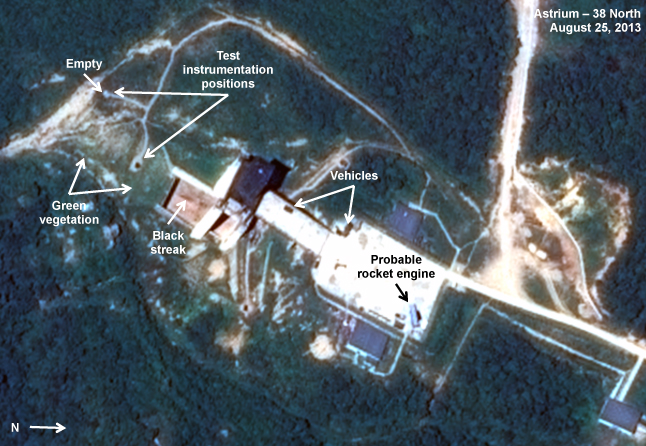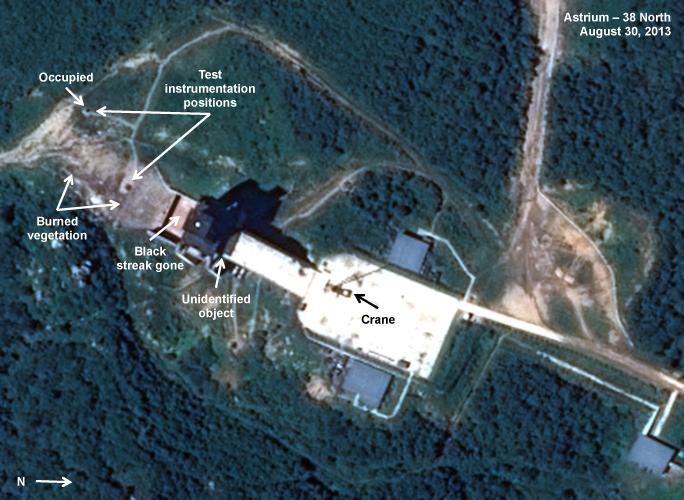Probable Rocket Engine Test Conducted at Sohae
Summary
New commercial satellite imagery indicates North Korea probably tested a long-range rocket engine between August 25and 30, 2013 at the Sohae Satellite Launching Station. This conclusion is based on analysis of imagery from before and after the probable test and a combination of indicators including the presence of a probable rocket stage, a crane necessary to mount and remove the rocket engine and propellant tanks on the test stand, instrumentation used to monitor tests as well as changes in the appearance of vegetation in front of the flame trench (from green to brown) and inside the flame trench located at the stand.
While the dimensions of the rocket stage—about 2.5 meters wide and 9-10 meters long—indicate use as a long-range rocket engine, it is not possible to positively identify the type of engine tested given uncertainties in the resolution of commercial satellite imagery. Other possibilities include the second stage of the Unha-3 space launch vehicle (SLV), an improved version of that engine or a second or third stage engine for a much larger rocket suspected to be under development.
Before the Probable Rocket Engine Test
Commercial satellite imagery from August 25, 2013 shows what appears to have been preparations for a static engine test in which a rocket body is placed in a test stand and fired. Several objects sit on the concrete pad next to the stand including what could be a rocket stage located in the southeast corner of the pad.
It is difficult to make exact measurements of the stage—although it appears to be about 2.5 meters wide and 9-10 meters long—or to positively identify the type of rocket engine. It is possibly the second stage of an Unha-3 space launch vehicle or an improved version of that engine. However, other possibilities include a second or third stage engine for a much larger DPRK rocket believed under development.
In addition, four vehicles are present on the pad, indicating activity at the test stand. Positions are visible where instruments and cameras are used to measure the properties of exhaust gasses from tests. The position directly in front of the flame trench appears to be a permanent shelter added in early 2012. The second position further out was added in mid- 2013 and as of August 25, was not occupied. The vegetation beyond the pad appears green and there is a notable black streak in the flame trench.
Figure 1. Probable pre-test activity.

Afterwards: A Combination of Indicators
An image from just five days later suggests that North Korea tested a rocket engine, a conclusion based on a combination of the following indicators:
- A crane necessary to mount and remove the rocket engine and propellant tanks on the test stand sits on the pad.
- The previously empty instrumentation position is now occupied with equipment.
- There is an unidentified object located on the pad just in front of the test stand. This is possibly a portion of the system used to fasten the rocket to the pad during a test or a plate to keep the flames from blowing back on the pad.
- The vegetation in front of the flame trench is now brown, probably as a result of flames and exhaust from an engine test burning it. (It is unlikely this area could have naturally turned brown in the five days between images.)
- The appearance of the flame trench has changed with the disappearance of the black streak.
Figure 2. Five days later

